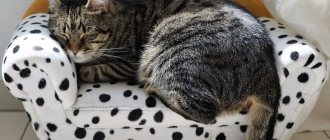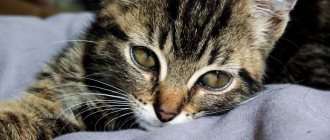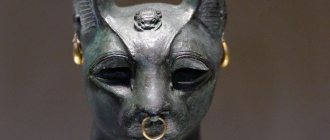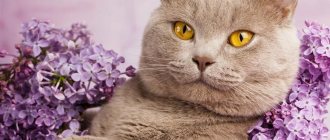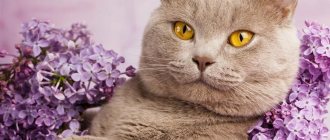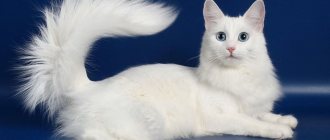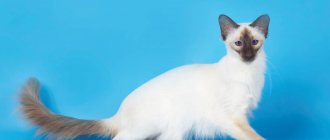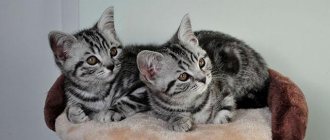The Celtic breed or European Shorthair cat was only recently recognized in the mid-twentieth century. The purpose of isolating this breed is to preserve the original appearance of ordinary domestic cats inhabiting the cities and suburbs of Europe. One of the most important advantages of these animals is their strong hunting qualities.
The first of those who began to breed European Shorthairs were breeders from countries such as Norway, Denmark and Sweden. Later, felinologists from France and Britain joined. In France today there are cats of blue color, called “tents”. In some countries, Celtic cats are called Carthusian. Breeders from England worked to breed large cats with a developed body, a round muzzle and dense fur. Later, it was from these cats that the beloved British breed originated.
It was only in 1982 that the Celtic cat breed was recognized as an independent breed. Now these cats, classified as shorthaired, hold the record for the number of variants of different colors. Only Oriental Shorthair and Persian cats can compete with them in this. They are one of the universal breeds that can live both in a city apartment and in a private home. At first, these cats may seem too simple, but their value lies in their naturalness.
Description of Celtic breed standards:
[advertising]
- the body has a medium size closer to large, developed muscles, flexibility, weight from 4 to 8 kg;
- a developed chest has a rounded shape;
- legs of medium length, strong and strong, paws large and oval;
- the tail is short, tapering at the tip;
- the head is wide, shaped closer to a triangle, with a straight nose and clear cheekbones;
- the neck is short and strong;
- the ears are not very large, rounded at the tips, sometimes with tassels, set wide apart and directed vertically;
- the eyes are round, expressive, wide open, the color matches the coat;
- The coat is short, dense, silky and shiny, and comes in many colors.
Brief history of the breed
The ancestors of the European or Celtic shorthaired breed were ordinary yard cats that lived side by side with humans in Northern Europe since the times of Ancient Rome.
Basically, people valued them for their hunting qualities - the animals exterminated rats and mice.
During the dark period of the Middle Ages, the number of cats decreased noticeably due to the efforts of the Inquisition. All black animals were declared accomplices of the devil and sent to the stake.
Over time, the population size recovered, and by the middle of the 19th century, first amateur breeders and then specialists paid attention to the characteristic animals. By the end of the century, the European cat was presented at exhibitions, but it did not receive official recognition as a breed.
At the beginning of the 20th century, felinologists in Denmark, Norway and Sweden seriously began breeding the breed. In 1946, Swedish breeders first registered the domestic cat. Later it received the name European Shorthair. The American line of selection also stood out separately.
Subsequently, the selection principles of British, American and Scandinavian felinologists diverged. To avoid confusion, the World Cat Federation has registered the Scandinavian breed as the "Celtic Shorthair". This includes animals that live in a specific area and meet fixed standards.
Thus, both names of the breed ─ European and Celtic Shorthair ─ are correct and equivalent.
Interesting Facts
Fans of purring creatures will be interested in the following information:
- It is surprising that the oldest breed in the world, the European Aboriginal, is also the youngest. It received its official name ─ “European or Celtic shorthair cat” in 1982;
- There is another variety of European cat - longhaired. This is a relative of the elegant “Celt” - a Siberian breed popular in Russia. It is widespread both in the Eastern European part of the continent and beyond the Urals;
- The Celtic Shorthair is more of a companion than a relative. This is her character, free and independent;
- On the scale of temperament, Celtic Shorthairs occupy the golden mean: affectionate without intrusiveness and leaders in spirit, but not aggressive.
Breed description, standards, appearance
Ideally, the standards for Celtic longhair cats include the absence of admixtures from other breeding lines. Working on the main characteristics of the European breed, breeders tried to consolidate the following features:
- unsurpassed trapping and hunting qualities;
- equanimity, stress resistance;
- attachment to home; I had to work hard on this quality, because the Celts are prone to vagrancy.
Dimensions and weight
Celtic cats are distinguished from other breeds by their pronounced sexual dimorphism. Females and males are very different from each other.
The Celtic cat breed ranges in size from medium to large. The girls are gracefully built, their standard weight is about 4 kg. European shorthair cats have a more powerful build, their weight is up to 8 kg.
Anatomical characteristics
Main characteristics in the description of the Celtic breed:
- the body is flexible, muscular, “high-slung”, with a straight back;
- developed, convex chest;
- strong limbs of medium length, tapering downwards, paws rounded;
- large head with pronounced cheeks, the transition from forehead to nose, large chin stand out in profile;
- The tail, wide at the base, tapers and rounds towards the tip;
- ears in the shape of an isosceles triangle, the distance between them is equal to the width of the ear. Tassels at the tips are acceptable, vertical fit;
- the eyes are slightly slanted and rounded. Their color should match the coat color. They are often green, blue, honey-amber. Heterochromia (eyes of different colors) is allowed.
Color and coat type
Representatives of the Celtic line have a dense, thick and short coat. The slightly pronounced undercoat determines its adherence to the body, elasticity and noble shine.
The standard includes more than 50 types of colors in natural shades. Range - from white to black. Some breeders of the European branch give preference to one particular rare color. They make it their trademark.
The most valuable are white European cats and tabby-colored animals: silver, golden, marbled.
Possible breed defects
Flaws that deviate from the standards of the European or Celtic Shorthair cat breed include:
- too wide muzzle ─ this is a sign of the British line of selection;
- visible signs of admixtures of other breeds;
- creases along the length of the tail, the presence of a tassel on it;
- white spots in the color: only the main background can be of this color;
- saggy cheeks.
Also, if all the standard external characteristics are present, the following colors are considered unacceptable in the Celtic line:
- faun (lightened beige);
- chocolate;
- Siamese;
- red or brown-red;
- lilac.
Character and temperament
The European Shorthair cat is intelligent and independent. She is calm and has self-esteem.
Having appeared in the house, the Celtic handsome man chooses a leader, a leader from among the family members. The owner becomes the idol of the European cat: the pet takes on the character, habits and temperament of the owner.
The animal easily adapts to the regime and conditions in the family, is emotionally involved in the relationship, but is not imposed. The short-haired pet tolerates loneliness well, does not get bored without company, and knows how to keep itself busy. Pets of the European breed are ideal for people who spend a lot of time at work.
Possessing a keen sense of territory, the Shorthaired Celt will not tolerate a competitor near him. Therefore, you should not buy another purr or puppy for a house where a cat of the European breed already lives.
Smaller animals: birds, hamsters or rats ─ should also be kept away, and it is better not to be kept in the same house as a Celtic cat. Her innate instinct as a predatory mousetrap will leave them no chance.
Despite such a harsh disposition, European Shorthair cats are sociable, playful and inquisitive. They will be happy to play with the baby. When communicating with children, the Celtic cat shows remarkable patience. He will not respond to aggression, he will simply leave the offender.
This pet does not tolerate familiarity and prefers partnerships.
A valuable quality of European shorthair cats is their silence. They will not meow without a good reason.
Care and maintenance
The main difference between the Celtic breed and others is its love for walks. European cats should be taken outside several times a week. They quickly get used to a harness and leash, and walks with their owner give them pleasure.
Otherwise, short-haired European purrs do not require any special conditions. Of course, the basic rules for caring for domestic cats will have to be followed:
- need to take care of the coat. To keep the coat of a European smooth-haired cat always shiny, it is enough to comb it with a special brush once a week, and during the molting period - every day;
- Regular care of ears, eyes and teeth is required, either on your own or with the help of a veterinarian;
- You need to trim your claws with special tweezers once a month. There must be a scratching post in the house;
- It is often impossible to bathe a Celtic Shorthair cat: this has a bad effect on the quality of the coat. One procedure every six months is enough;
- Vaccinations and antiparasitic measures should be carried out on time. The schedule of procedures will be drawn up by a veterinarian. The first vaccination is carried out on a kitten at the age of 2-3 months.
The European Shorthair cat, like any other cat, must have permanent places for feeding, toileting and resting. The bed should be placed away from heating devices, but not in a draft. The entire room should be visible from it. This will allow the European pet to feel safe.
Lifespan
On average, Celts live from 15 to 17 years. However, the care of the owner plays a big role in this matter. The European Shorthair cat needs to be vaccinated like any other cat. They receive their first vaccinations at the age of 2–3 months. From 4 to 7 months, vaccination is not carried out, since in small Celts at this time, milk teeth are replaced by “adult” ones.
In addition to vaccinations, the health and life expectancy of a cat is influenced by the care of the owner. If a cat eats properly, spends a lot of time in an active state and is not attacked by germs and viruses, then it will live to old age. When I was little, my grandmother had a cat, Musya. She went outside every day, gave birth every year, and ate natural food specially prepared by her grandmother. At the age of 20, Musya looked like an old woman - her eyes seemed tired, her fur was faded, and her gait was heavy. And most of my current neighbors’ cats do not live to be 15 years old, although they are pampered and often shown to the veterinarian.
Some European cats live to be 18 years old, but this depends on how well they are cared for
How to choose the right kitten
For a purebred Celtic Shorthair kitten, you should contact only special nurseries or trusted breeders.
The key to making the right choice is that the parents of the European baby have the appropriate documents about the breed ─ passports or certificates. They are transferred to the buyer upon sale.
You should pay attention to the appearance of the mother. There must be pronounced signs of the European Shorthair breed and compliance with the standards.
Typically, kittens are weaned from their mother and sold at 2.5 months. By this time, children are supposed to undergo anthelmintic treatment and vaccination and have a certificate about this from a veterinarian. The short-haired European animal must be litter trained and feed on its own.
The character of a two to three month old Celtic kitten is already clearly expressed. The future owner chooses a companion in accordance with his own temperament and needs.
Kitten care
No special skills are required in caring for a short-haired European baby. All he needs is attention and affection. At first, the new owner will have to replace the European kitten’s mother ─ kind, but strict.
It is immediately necessary to determine the place of feeding and toilet for the pet and ensure strict compliance with the rules.
At first, you will have to devote more time to your short-haired European baby, pick him up more often, and stroke his tummy so that there are no problems with stool.
Later, when the new tenant gets comfortable in the house, he will find something to do with himself. To keep your little Celtic European physically active, you can purchase several toys.
In general, caring for kittens is the same as for adult European purrs.
A short-haired Celtic baby should be fed frequently, in small portions, by chopping the food. Experienced breeders recommend leaving food overnight. Special food for kittens, dry and wet, is best suited for nutrition.
Your veterinarian will recommend vitamin supplements. Babies have a high metabolism, they quickly become hungry. After changing teeth, at 7-8 months of age, a European kitten can be switched to adult food.
Feeding the cat
The European Shorthair is unpretentious in nutrition, has a good appetite and is not susceptible to diseases of the gastrointestinal tract. She does not need to follow a special diet. If desired, the owner can choose one of two feeding options for the Celtic Shorthair cat:
- ready-made food, a wide range of which is presented in special departments of any supermarket. It's not too budget-friendly, but convenient;
- table made from natural products. It will take time to prepare, but it is accessible, healthy and inexpensive.
Natural food for the Celtic Shorthair includes:
- boiled or scalded meat and offal;
- vegetables (except legumes and eggplants);
- boiled fish;
- cereal porridges and soups;
- dairy products.
The natural diet of a European cat must be supplemented with vitamin and mineral complexes. You can buy them at veterinary pharmacies.
To avoid health problems for the short-haired purr, the following are strictly prohibited:
- all products from the master's table, especially smoked meats, sausages, fried, fatty and sweet foods;
- milk: some animals are lactose intolerant;
- raw fish: the risk of helminth infection is significant.
An adult European cat should be fed 2-3 times a day. Clean water must be available at all times.
Diet
The European Shorthair has no special food requirements. Kittens up to 3 months are fed (with an emphasis on dairy products) 6 times a day, after 4 months they are transferred to 2 meals a day. The Celtic cat can easily adapt to commercial food (dry and wet) labeled “super-premium” or “holistic”.
Pelleted food goes well with a natural diet. For the latter we recommend:
- meat (raw and cooked);
- sea fish (fresh and boiled);
- vegetables (in various forms, except fried);
- eggs;
- fermented milk products;
- porridge.
The menu should not be dominated by carbohydrates: a cat, like any predator, needs animal proteins. In addition, raw/solid foods will benefit from helping to clear away plaque.
Education and physical activity
Representatives of the European Shorthair breed are intelligent, smart and independent. In the process of raising and communicating with a Celtic cat, you need to be respectful and patient. The animal is well versed in the intonations of the human voice.
Demandingness and affection, perseverance and consistency will help in raising an obedient and equal family member. Screaming and rough handling will make a neurasthenic out of the Celtic Shorthair.
To prevent your cat from damaging the furniture, you need to purchase a scratching post. The European Shorthair should be provided with a place for outdoor games and climbing. It is necessary to remove all objects that could break from horizontal surfaces. Wires from electrical appliances are supposed to be hidden from the Celtic cat.
The ideal option would be to purchase a special complex for cats. Pet stores have a large selection of interactive toys. Having fun with them, a European shorthair cat can keep itself busy for a long time.
Necessary living conditions
The European Shorthair cat can adapt to almost any conditions, but to make it comfortable, you need to create a corner for rest and sleep. Some owners install a cat house or playground in their apartment, and if this is not possible, then at least a bed is needed. The cat’s “bedroom” should be located in such a corner of the room that when lying down she can see the whole room - this way she feels safe (but away from heating devices, otherwise problems with the fur will arise). To prevent your cat from damaging furniture, wallpaper or things with its claws, you need to take care of the scratching post.
Even before purchasing an animal, collect a “dowry” for the Celt. You will need bowls (for water and food separately), brushes, care products, nail clippers, tray, litter, etc. For the healthy development and growth of an animal, toys are needed (especially if we are talking about a kitten). Fortunately, cat entertainment is inexpensive and sold in every store.
I have a large basket at home that was once purchased to store a children's construction set. Now it is filled to the brim with cat balls, mice and bones. Every time a new kitten appears, it’s hard for me to resist making such purchases, but lately I’ve been trying to make toys myself. For example, I made a scratching post that you can play with. I put a pebble in a plastic Christmas ball and sealed the neck of the ball. I wrapped the whole thing with jute rope using a glue gun. The younger cat loves this thing: she chews it, sharpens her claws, and forgot about the sofa.
Celtic cats are playful and active, so they definitely need toys.
Sterilization and castration
If the owner of the Celtic beauty does not plan to regularly produce offspring, the animal should be sterilized (cat) or neutered (male). This can be done when the European pet reaches the age of 8-9 months. The time for the operation must be chosen correctly: females should not be in heat, and males should not be in heat.
There is no need to be afraid of interference. If it is performed by an experienced specialist under anesthesia, it will not cause harm.
It is much more dangerous to regularly suppress the sexual instinct with hormonal drugs. If used frequently, they can cause irreversible changes in the body of a European cat.
Tumor and cystic formations often occur in the abdominal cavity. In this case, complex surgical intervention cannot be avoided, and the postoperative period will be difficult.
Knitting features
The first mating of a European cat should take place at the age of approximately 1.5 years. Most Celts are in their third heat by this time. The first thing the owner should do is examine the cat and make sure it is healthy (deworming, vaccination, etc.). It is advisable to look for a partner with experience. To give birth to beautiful, healthy and purebred kittens, you need an equally good partner for your cat. In such cases, they usually turn to professional breeders or felinological (breeding) organizations.
Mating can be paid or barter (1 or several kittens will need to be left to the other party). If your Celt is a champion, then your partner must also have the appropriate documents. Some Celtic owners breed their cats with representatives of other breeds, but such owners are considered unscrupulous - such crossings are prohibited.
Pregnancy in Celtic cats is easy, and childbirth usually occurs without complications. Cases of the birth of “rejected” kittens are rare. If you don’t need Celtic offspring, then the cat or female cat needs to be spayed/neutered. You don’t have to wait 1.5 years for this. The procedure can be performed when the animal is 8–9 months old. Sometimes owners miss this period, and the cat may go into estrus (or heat in males). When searching for a partner or preparing for surgery, owners often resort to hormonal drugs. However, this is not recommended, since “silencing” instincts can adversely affect the health of the animal.
It is not recommended to crossbreed a European Shorthair cat with representatives of other breeds.
Pros and cons of the breed
Naturally, keeping any animal in the house introduces some inconveniences into the family’s usual way of life. But what are small everyday problems worth compared to the happiness of communicating with wonderful cats!
Of course, you need to choose a pet with open eyes, clearly understanding the pros and cons of a particular breed. The Celtic Shorthair cat has virtually no disadvantages.
| Advantages | Flaws |
| Good health, absence of genetically determined diseases | Sometimes too independent and stubborn |
| Does not require large material costs or special efforts to maintain | It may be difficult to acquire a purebred European smoothhair cat |
| Hardly suitable for show enthusiasts and breeders. | |
| The European cat breed is unpretentious in nutrition | The Celtic breed is not popular among domestic breeders |
| Good-natured disposition. Affectionate without intrusiveness | |
| Self-sufficient, independent | |
| Silent, rarely meow | |
| Loyal to their master |
The character of a Celtic cat is a reflection of the soul and temperament of its owner. Its peculiarity is the combination of incongruous things: devotion and independence, gentleness, accommodatingness and stubbornness. European purrs respond to affection and love in full reciprocity.
The cheerfulness of the Celtic Shorthair cat is captivating. Kind, smart, but at the same time crafty and independent, Celts are ideal for keeping in a family.
There is nothing exotic in the appearance of European shorthair cats. But they have lived next to a person for so many centuries that, looking into their eyes, you can see the Soul.
Price
The cost of kittens depends on their pedigree and varies from 5,000 to 30,000 rubles. However, you need to be especially vigilant with this breed - instead of a purebred animal, you can easily buy an ordinary yard Murzik. In principle, no one will notice the difference.
The Celtic cat is a rather rare breed for Russia; not all breeders breed it, and to the question “Where to buy a Celtic cat” it is better to look for the answer on the Internet or check with any cat club.
